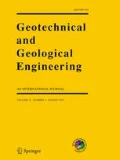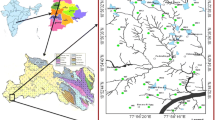Abstract
The chemical property of groundwater depends largely on the mineralogical composition of the rocks through which the water has moved and the rate of movement and these characteristics of surface water depend on organic and inorganic reactions, industrial effluents, rainfall and temperature etc. The underground water tends to contain more dissolved materials than those in surface water because of their more intimate and longer contact with organic materials of soil and rock particles. The groundwater of the studied area is dominant of alkaline earth’s (Ca2+ and Mg2+) and weak acids (HCO3 −) which may be classified as Magnesium-Bicarbonate and Calcium Carbonate types. Genetically, the groundwater of the area belongs to both “Normal Chloride” “Normal Sulphate” and “Normal Carbonate” to “Super Carbonate” group. Based on EC, SAR and RC, the groundwater of the area varies from good–excellent quality for irrigation purposes with low alkali hazard and medium salinity hazard.






Similar content being viewed by others
References
Ahmed SA, et al. (2000) Arsenic: Water Contamination and Health Hazard, pp 7–62
Back W (1961) Origin of hydrochemical facies of groundwater in the Atlantic coastal plain, Int. Geo. Congress. Copenhagen pp 87–95
BWPCB (Bangladesh Water Pollution Control Board) (1976) Water quality standard, 2
Davis J, Exley C (1992) Hydrochemical character of the main aquifer units of Central and North-Eastern Bangladesh and possible toxicity of groundwater to fish and humans, Final Report, British Geol. Survey., Technical Report, WD/92/43R
Doneen LD (1967) The influence of crop and soil on percolating waters; Proc. Biennial Conference On Groundwater Recharge, 1961
Gupta HP (1987) Paleoenvironments during holocene time in Bengal Basin, India as reflected by palynostratigraphy. The Paleobotanist 27(2):138–160
Karim SM, Ahmed SS (2002) Ahmed M and Islam S: Arsenic contamination of Ground water of Satma Village, Sharsha Thana, Jessore, University of Rajshahi (in press)
Loyed JW, Heathcote JA et al (1985) Natural inorganic hydrochemistry in relation to groundwater, An introduction. Claredon Press, Oxford 291 p
Olson RV, Ellis R Jr (1982) Iron. In: Page AL, Miller RH, Keeney DR (eds) Methods of soil analysis, Part 2, 2nd edn. American Society of Agronomy and Soil Science Society of America, Madison, pp 301–312
Piper AM (1953) A graphic procedure in the geochemical interpretation of water-analysis, USGS Groundwater note, no 12
Todd DK (1980) Groundwater hydrology, 2nd edn. Willey, USA, p 70
WHO (World Health Organization) (1984) Guide line for drinking water quality. WHO, Geneva
Acknowledgments
The authors are thankful to anonymous reviewers for their critical reading, valuable suggestions and discussions which help to improve this article greatly. The authors are also grateful to the Editor-in-Chief of the journal for his kind co-operation to publish the research.
Author information
Authors and Affiliations
Corresponding author
Rights and permissions
About this article
Cite this article
Hossain, G., Howladar, M.F., Nessa, L. et al. Hydrochemistry and Classification of Groundwater Resources of Ishwardi Municipal Area, Pabna District, Bangladesh. Geotech Geol Eng 28, 671–679 (2010). https://doi.org/10.1007/s10706-010-9326-4
Received:
Accepted:
Published:
Issue Date:
DOI: https://doi.org/10.1007/s10706-010-9326-4




